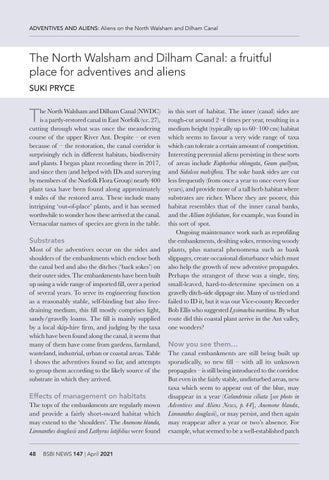ADVENTIVES AND ALIENS: Aliens on the North Walsham and Dilham Canal
The North Walsham and Dilham Canal: a fruitful place for adventives and aliens SUKI PRYCE
T
he North Walsham and Dilham Canal (NWDC) is a partly-restored canal in East Norfolk (v.c. 27), cutting through what was once the meandering course of the upper River Ant. Despite – or even because of – the restoration, the canal corridor is surprisingly rich in different habitats, biodiversity and plants. I began plant recording there in 2017, and since then (and helped with IDs and surveying by members of the Norfolk Flora Group) nearly 400 plant taxa have been found along approximately 4 miles of the restored area. These include many intriguing ‘out-of-place’ plants, and it has seemed worthwhile to wonder how these arrived at the canal. Vernacular names of species are given in the table.
Substrates
Most of the adventives occur on the sides and shoulders of the embankments which enclose both the canal bed and also the ditches (‘back sokes’) on their outer sides. The embankments have been built up using a wide range of imported fill, over a period of several years. To serve its engineering function as a reasonably stable, self-binding but also freedraining medium, this fill mostly comprises light, sandy/gravelly loams. The fill is mainly supplied by a local skip-hire firm, and judging by the taxa which have been found along the canal, it seems that many of them have come from gardens, farmland, wasteland, industrial, urban or coastal areas. Table 1 shows the adventives found so far, and attempts to group them according to the likely source of the substrate in which they arrived.
Effects of management on habitats
The tops of the embankments are regularly mown and provide a fairly short-sward habitat which may extend to the ‘shoulders’. The Anemone blanda, Limnanthes douglasii and Lathyrus latifolius were found 48
BSBI NEWS 147 | April 2021
in this sort of habitat. The inner (canal) sides are rough-cut around 2–4 times per year, resulting in a medium height (typically up to 60–100 cm) habitat which seems to favour a very wide range of taxa which can tolerate a certain amount of competition. Interesting perennial aliens persisting in these sorts of areas include Euphorbia oblongata, Geum quellyon, and Sidalcea malviflora. The soke bank sides are cut less frequently (from once a year to once every four years), and provide more of a tall herb habitat where substrates are richer. Where they are poorer, this habitat resembles that of the inner canal banks, and the Allium trifoliatum, for example, was found in this sort of spot. Ongoing maintenance work such as reprofiling the embankments, desilting sokes, removing woody plants, plus natural phenomena such as bank slippages, create occasional disturbance which must also help the growth of new adventive propagules. Perhaps the strangest of these was a single, tiny, small-leaved, hard-to-determine specimen on a gravelly ditch-side slippage site. Many of us tried and failed to ID it, but it was our Vice-county Recorder Bob Ellis who suggested Lysimachia maritima. By what route did this coastal plant arrive in the Ant valley, one wonders?
Now you see them…
The canal embankments are still being built up sporadically, so new fill – with all its unknown propagules – is still being introduced to the corridor. But even in the fairly stable, undisturbed areas, new taxa which seem to appear out of the blue, may disappear in a year (Calandrinia ciliata [see photo in Adventives and Aliens News, p. 44], Anemone blanda, Limnanthes douglasii), or may persist, and then again may reappear after a year or two’s absence. For example, what seemed to be a well-established patch
















